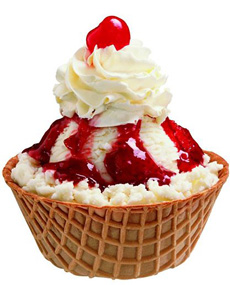TIP OF THE DAY: Waffle Bowls (Ice Cream Cone Cups)
 Strawberry sundae in a cone cup. Photo courtesy Joy Cone Co. |
Can’t decide between a cup of ice cream or a cone? Have two in one with a cone cup, a.k.a. waffle bowl.
Perfect for customers who have trouble deciding whether they want their ice cream served in a cone or a dish, this waffle bowl from Joy Cone Company offers the best of both worlds! Joy, world’s largest ice cream cone company, has been family owned and operated since 1918. It’s proof that you can be the biggest and still turn out a top-quality product. The cones and cone cups are made with a blend of cake and pastry flours that produce a light-tasting cone with subtly sweet taste that does not overpower the ice cream—and can be used for savory recipes as well. The waffle bowl uses the same batter as the company’s waffle cone. Dark brown sugar is used in the recipe. Many other brands, says Joy, use white or liquid sugar with added molasses, which gives a burnt aftertaste when compared to Joy’s recipe. Beyond sundaes, you can use these bowls for numerous sweet and savory recipes. The sturdy waffle bowl does not get soggy. |
|
|
Sweet Foods & Snacks In Waffle Bowls |
||
|
Nonsweet Foods In Waffle Bowls Here’s a store locator for the waffle bowls. ICE CREAM CONE HISTORY Most sources, including the International Dairy Foods Association, say that the first ice cream cone was produced in New York City in 1896 by Italo Marchiony. An Italian immigrant, he was granted a patent in December 1903 for “small pastry cups with sloping sides.” The bottoms were flat, not conical, much like today’s molded cones. |
 Broccoli salad, one of numerous savory salads that can be served in waffle cups. Photo courtesy Joy Cone Co. |
|
|
Another story cites an independent creation accidentally born at the 1904 World’s Fair in St. Louis. According to the story, Ernest A. Hamwi, a Syrian concessionaire, was selling a crisp, waffle-like pastry called zalabia*; as were other concessionaires. A neighboring ice cream vendor ran out of clean glass dishes. Hamwi rolled one of his waffles into the shape of a cornucopia; the fresh-made “cone” cooled in a few seconds and the ice cream vendor was able to put a scoop of ice cream in it. Three different ice cream vendors claimed credit. In a 1928 letter to the Ice Cream Trade Journal, Hamwi reported that it was either Arnold Fornachou or Charles Menches who ran the ice cream booth next to him. Others also lay claim. But while the ice cream cone was popularized in America, it was not invented here. Robin J. Weir, co-author of the book, Frozen Desserts, has spent years researching this topic. He purchased a print dated 1807 of a young woman eating an ice cream cone at the Gardens Of Frascati, a Parisian café known for its ices. Was it glass or edible? It’s hard to tell. An 1820 print of an ice cream seller in Naples shows glass cones on his cart. This is a story shrouded in the mists of history—and the real answer may still be out there. Here’s more about the invention of the ice cream cone.
|
||


